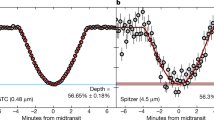Abstract
THE recent discovery1 and confirmation2 of a possible planetary companion orbiting the solar-type star 51 Pegasi represent a breakthrough in the search for extrasolar planetary systems. Analysis of systematic variations in the velocity of the star indicate that the mass of the companion is approximately that of Jupiter, and that it is travelling in a nearly circular orbit at a distance from the star of 0.05 AU (about seven stellar radii). Here we show that, if the companion is indeed a gas-giant planet, it is extremely unlikely to have formed at its present location. We suggest instead that the planet probably formed by gradual accretion of solids and capture of gas at a much larger distance from the star (∼5 AU), and that it subsequently migrated inwards through interactions with the remnants of the circumstellar disk. The planet's migration may have stopped in its present orbit as a result of tidal interactions with the star, or through truncation of the inner circumstellar disk by the stellar magnetosphere.
Similar content being viewed by others
References
Mayor, F. & Queloz, D. Nature 378, 355–359 (1995).
Marcy, G. & Butler, R. P. IAU Circ. No. 6251 (1995).
Lin, D. N. C. & Papaloizou, J. in Protostars and Planets II (eds Black, D. C. & Matthews, M. S.) 981–1072 (Univ. Arizona Press, Tucson, 1985).
Beckwith, S. V. W., Sargent, A. I., Chini, R. & Güsten, R. Ast J. 99, 924–945 (1990).
Wetherill, G. W. A. Rev. Astr. Astrophys. 18, 77–113 (1980).
Bodenheimer, P. & Pollack, J. B. Icarus 67, 391–408 (1986).
Cameron, A. G. W. Moon Planets 18, 5–40 (1978).
Laughlin, G. & Bodenheimer, P. Astrophys. J. 436, 335–354 (1994).
Laughlin, G. & Bodenheimer, P. Astrophys. J. 403, 303–314 (1993).
Stringfellow, G., Black, D. C. & Bodenheimer, P. Astrophys. J. 349, L59–L62 (1990).
Saumon, D., Chabrier, G. & Van Horn, H. M. Astrophys. J. Suppl. Ser. 99, 713–741 (1995).
Goldreich, P. & Soter, S. Icarus 5, 375–389 (1966).
Shu, F. H. The Physical Universe 441 (University Science Books, Mill Valley, CA, 1982).
Zahnle, K. in Protostars and Planets III (eds Levy, E. & Lunine, J.) 1305–1338 (Univ. Arizona Press, Tucson, 1993).
Burrows, A. & Lunine, J. Nature 378, 333 (1995).
Pollack, J. B. et al. Icarus (submitted).
Lin, D. N. C. & Papaloizou, J. C. B. Mon. Not. R. astr. Soc. 186, 799–812 (1979).
Papaloizou, J. C. B. & Lin, D. N. C. Astrophys. J. 285, 818–834 (1984).
Lin, D. N. C. & Papaloizou, J. C. B. in Protostars and Planets III (eds Levy, E. & Lunine, J.) 749–836 (Univ. Arizona Press, Tucson, 1993).
Strom, S. E., Edwards, S. & Skrutskie, M. F. in Protostars and Planets III (eds Levy, E. & Lunine, J.) 837–866 (Univ. Arizona Press, Tucson, 1993).
Goldreich, P. & Tremaine, S. Astrophys. J. 241, 425–441 (1980).
Lin, D. N. C. & Papaloizou, J. C. B. Astrophys. J. 309, 846–857 (1986).
Takeuchi, T., Miyama, S. & Lin, D. N. C. Astrophys. J. (in the press).
Mathieu, R. D. A. Rev. Astr. Astrophys. 32, 465–530 (1994).
Skumanich, A. Astrophys. J. 171, 565–567 (1972).
D'Antona, F. & Mazzitelli, I. Astrophys. J. Suppl. Ser. 90, 467–500 (1994).
Bouvier, J., Cabrit, S., Fernandez, M., Martin, E. L. & Matthews, J. M. Ast. Astrophys. 272, 176–206.
Königl, A. Astrophys. J. 370, L39–L43 (1991).
Shu, F. H. et al. Astrophys. J. 429, 781–796 (1994).
Goldreich, P. & Tremaine, S. Astrophys. J. 233, 857–871 (1979).
MacGregor, K. & Bremner, M. Astrophys. J. 376, 204–213 (1991).
Author information
Authors and Affiliations
Rights and permissions
About this article
Cite this article
Lin, D., Bodenheimer, P. & Richardson, D. Orbital migration of the planetary companion of 51 Pegasi to its present location. Nature 380, 606–607 (1996). https://doi.org/10.1038/380606a0
Received:
Accepted:
Issue Date:
DOI: https://doi.org/10.1038/380606a0
- Springer Nature Limited
This article is cited by
-
Free-floating binary planets from ejections during close stellar encounters
Nature Astronomy (2024)
-
Breaking waves on the surface of the heartbeat star MACHO 80.7443.1718
Nature Astronomy (2023)
-
Jupiter-like planets might be common in a low-density environment
Nature Communications (2023)
-
Protoplanetary Disk Science with the Orbiting Astronomical Satellite Investigating Stellar Systems (OASIS) Observatory
Space Science Reviews (2023)
-
Ariel planetary interiors White Paper
Experimental Astronomy (2022)





